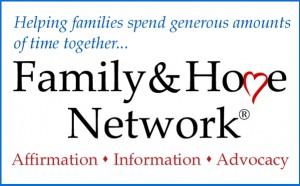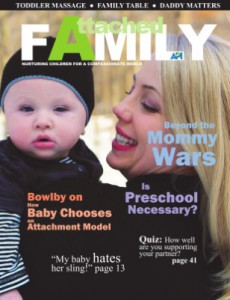By Rita Brhel, API Leader, API’s Publications Coordinator
 It has only been about 20 years since Dr. William Sears coined the term “Attachment Parenting” in reference to a set of nurturing parenting practices, such as babywearing and breastfeeding.
It has only been about 20 years since Dr. William Sears coined the term “Attachment Parenting” in reference to a set of nurturing parenting practices, such as babywearing and breastfeeding.
Today, Attachment Parenting International has helped to expand this approach to parenting to include children beyond the infant years and to secondary attachment figures including grandparents.
The Value of Secondary Attachment to a Child
Mothers have long since been the focus of Attachment Parenting information, the role of secondary attachments cannot be ignored. According to the article “Back to the Future: How Early Attachments Shape Your Relationships” in the Summer 2007 issue of Attachment Parenting, all attachments whether parent-child or grandparent-grandchild play a crucial role in shaping what a child’s perspective of what “normal” relationships are like.
“It refers to the ‘image’ of love people carry inside them that consists of the positive and negative characteristics of all their childhood caretakers,” according to the article’s author and Imago Relationship Therapy therapist Rod Kochtitzky. As adults, “we are left with someone who both loves us in the ways we were loved in our family of origin and also hurts us in ways that we were hurt in our families.”
Grandparents Provide a Vital Relationship to Children
Obviously, grandparents whose grandchildren live with them or are being raised by them play a vital role as primary caregivers to those grandchildren.
But even grandparents whose grandchildren do not live with them have a critical role in supporting their grandchildren’s parents. Grandparents can be great sources of parenting tips – and affordable childcare – to their grandchildren’s parents.
But it is those whose grandchildren who are in high risk situations, such as poverty and stressful family events, who can really make a difference in helping to shape a child’s sense of normalcy in relationships.
The Protective Role of Grandparents
For example, the 2007 article “The Protective Role of Grandparents” by Kate Fogarty, PhD, in the University of Florida’s Family, Youth, and Consumer Sciences newsletter, explored the effect of a healthy grandparent-grandchild bond on the negative effects of maternal depression on parenting and a child’s functioning.
According to Fogarty, compared to non-depressed mothers, those with depression typically have minimal, inconsistent responses to their children’s needs; express more negative than positive emotions toward their children; and are less engaged when interacting with their children.
These parenting behaviors lead to inhibited cognitive development and increased behavior problems in the children of all ages. Teenagers feel these effects especially strongly, because they influence their social and academic functioning. Furthermore, school-aged children and teenagers of depressed mothers are significantly more likely to be depressed as adults.
Fogarty then referenced a study (Silverstein & Ruiz, 2006, “Breaking the Chain: How Grandparents Moderate the Transmission of Maternal Depression to Their Grandchildren,” published in Family Relations, 55) showing that the stronger the attachment of the grandchild to a grandparent, the less likely the child of a depressed mother is to experience depression in adulthood.
What Determines a Strong Grandparent-Grandchild Bond?
The Silverstein study listed these elements to be crucial in developing a strong grandparent-grandchild relationship:
- The child feeling a sense of emotional closeness to his grandparent;
- The child having regular contact with his grandparent;
- The child viewing his grandparent as a source of social support.
A strong emotional bond with the grandparent effectively models a healthy relationship, lessening the negative effects of parenting by a depressed mother, who is often the primary caregiver. Imagine the very positive effect grandparents can have in their grandchildren’s lives, if they’re already receiving a healthy relationship model at home.
Interactions Shape the Brain, Young or Old
Daniel Goleman, PhD, discovered that every person-to-person interaction literally shapes the human brain – and that the more important the relationship, the more profound the effect of those interactions on brain development. This research was reviewed in Mark Matousek’s article “We’re Wired to Connect,” originally published in the January/February 2007 issue of AARP Magazine and later reprinted in the Summer 2007 issue of Attachment Parenting: The Journal of Attachment Parenting International.
“Young or old, people can affect our personalities,” writes Matousek. “…Anger-prone people, for example, can ‘infect’ themselves with calmness by spending time with mellower individuals, absorbing less aggressive behavior and thereby sharpening social intelligence.”
Matousek quoted Goleman in crediting his two-year-old grandchild in helping to maintain his emotional health, likening time spent with her as “a vitamin” or “an elixir.” Think of the influence of his emotions on an impressionable toddler!
The Valued Grandparent
Besides modeling what constitutes a “normal” relationship, grandparents provide children with a sense of safety and protection, a link to their cultural heritage and family history, and a companion in play and exploration, according to an article by Mary Gavin, MD, on http://kidshealth.org entitled “Bonding with Grandparents.”
Roma Hanks, PhD, speaks highly of the role of grandparents in her article “Connecting the Generations: The New Role of Grandparents,” published in the 1997 issue of The Harbinger at Mobile, Alabama: “It is my belief that grandparenting is the most important family role of the new century. …Today, there is a growing alliance of grandparents who will positively influence the lives of their grandchildren and the younger generations in their society, some by providing urgently needed daily care, others by building deep emotional connections with their grandchildren.”
“It is my belief that grandparenting is the most important family role of the new century.”
~ Roma Hanks, PhD
 There is a widespread belief that to be a good Attachment Parenting (AP) family, one parent must stay at home with the children full-time and that parent should be the mother. To be sure, this is a myth.
There is a widespread belief that to be a good Attachment Parenting (AP) family, one parent must stay at home with the children full-time and that parent should be the mother. To be sure, this is a myth.



